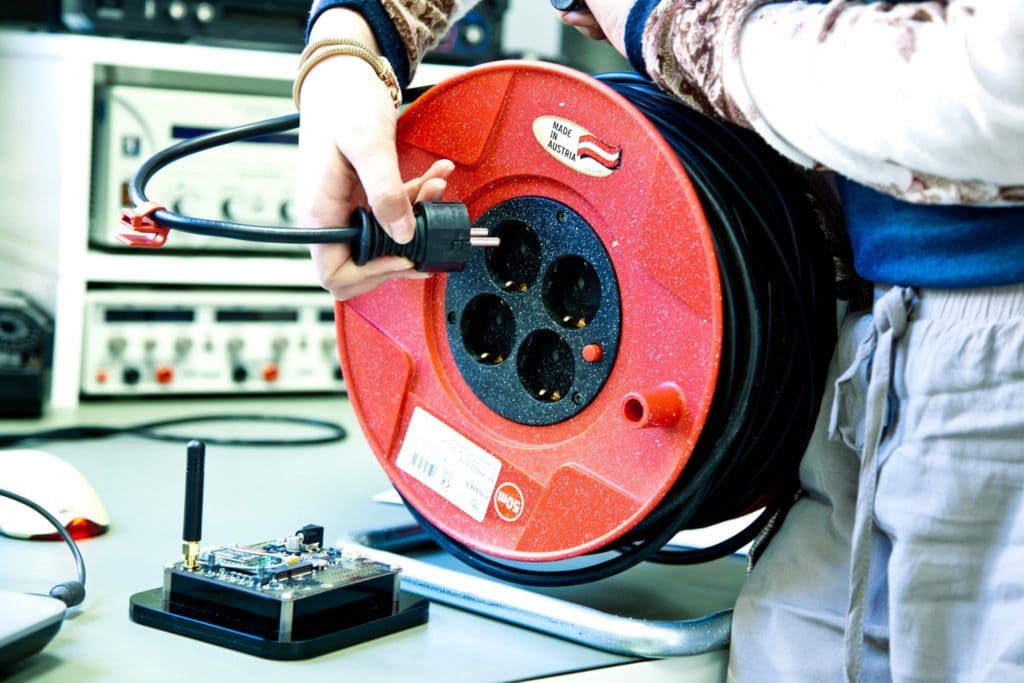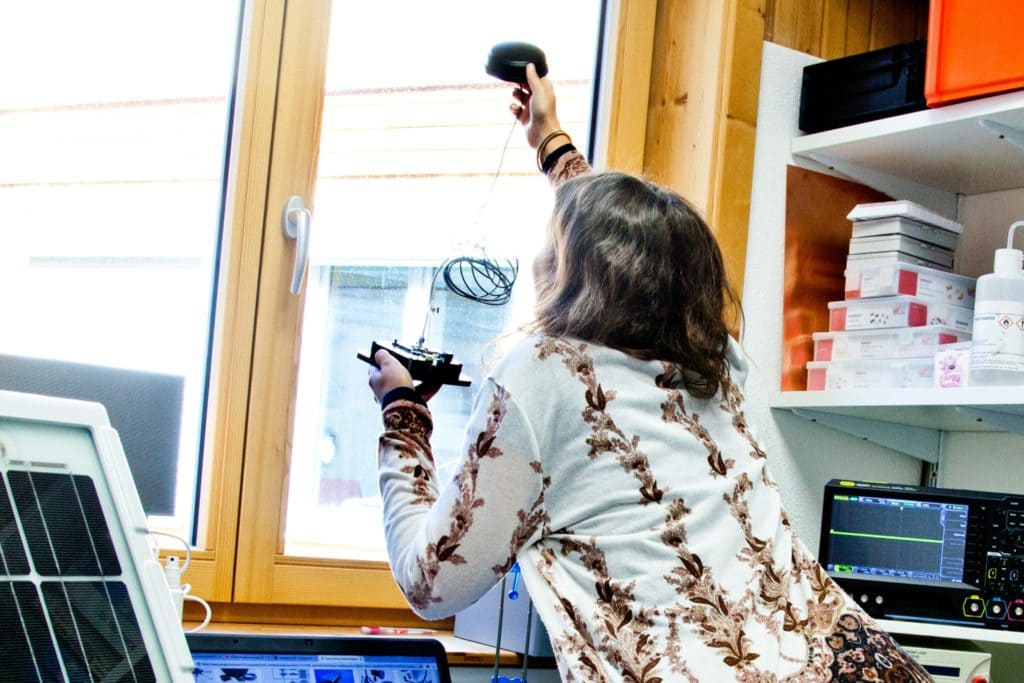The energy supply and the antenna of an IoT device have a much closer connection than it may seem at first sight. If the device is located in a zone with a low signal strength at the edge of a coverage area, for example, the modem is instructed by the cellular network to increase its transmitting power to uphold the communication. This results in a considerably increased energy demand and in this case, therefore the requirements for the energy supply rise.
Especially when using the 2G mobile communication standard the precise observance of the signal forms plays a critical role (i.e. the steepness of pulse edges). With an increasing transmission power, the production of a signal conforming to standards is more demanding for the energy source due to the signal’s higher amplitude. Therefore, the source has to be capable of switching between high and low currents very quickly.
Requirements for the voltage regulator
The concept of a voltage regulator meeting these requirements provides several challenges. For example, if an unfavourable choice of hardware design has been made, the controller could start oscillating in the course of a change of load, i.e. its output voltage is not constant, but it fluctuates. In this case, the modem’s minimum permissible supply voltage could be undercut and it could activate its reset circuit, which consequently puts the modem back into its initial state. Furthermore, interference pulses could be generated and emitted through fluctuations of the output signal, which influence other devices in the vicinity.

In complex IoT devices the modem usually only serves for communication and is controlled by an application on the main controller. Frequently, the modem and the main controller have different minimum thresholds for voltage supply and thus undefined states can occur, for example the modem is reset due to a voltage drop, but the main controller continues to work.
Moreover, a voltage converter for the supply of an IoT device has to be adjusted to the type of energy source. If the device is fed through the on-board supply system of a motor vehicle, for example, appropriate protective circuits should be provided to avoid an unwanted behaviour or damage, for example due to the burst in the starting process.
Pitfalls when using rechargeable batteries
An eminently suitable alternative to voltage regulator is the use of rechargeable batteries. Due to their very low internal resistance they are also able to deliver high currents without the risk of a fluctuating output voltage and the related problems, for instance unwanted resets.

However, there are pitfalls. When using a connection cable with a small cross section and/or long length, the internal resistance is increased. When a high transmission resistance is combined with an unfavourable choice of connector plug, the voltage drops occurring at current spikes can ensure that the voltage supply for the modem falls below the minimum threshold, the reset circuit hence puts the modem into the initial state.
The problem aggravates when the rechargeable batteries are almost discharged, as their output voltage continually decreases during the discharge, whereas the output voltage of lithium batteries, for example, is virtually consistent until their capacity is depleted. Although modern rechargeable batteries based on lithium stand out due to their small frame size and high capacity, an IoT device cannot be provided with endless power.
Increasing the complexity with self-sufficient operation
In order to ensure autarkic activity, rechargeable batteries can be combined with a solar field. In doing so, the complexity is increased as well, not only the parasitic resistors are relevant, but you also have to design a charging regulator, which optimally uses the available externally provided power without draining the battery by charging and discharging frequently.

The charging regulator can be dimensioned in a way that it constantly keeps the battery below the end-of-charge-voltage, instead of charging it until the end voltage is reached and then deactivating it. As a consequence, the capacity is reduced but the working life of the rechargeable battery is prolonged at the same time. When designing the charging regulator, the same difficulties as when designing the voltage regulator must be resolved.
Additional options with permanent supply
As an alternative to a solar field, rechargeable batteries can also be combined with a permanent supply, which opens up several additional cases of applications. Due to the rechargeable battery, in case of an outage of the permanent supply, for example, an alarm message can be emitted and/or the device continues to work during the downtime. As in this scenario it is always known how much energy is available, as opposed to using a solar field, other strategies to reduce charge and discharge cycles and the involved protection of the rechargeable batteries can be established.
A circuit could be designed, for example, that only switches to the rechargeable battery when the external supply fails. For this purpose, the possibility to use so-called PowerPath Controllers or Power Management ICs arises, which often only need a few additional components to accomplish this task. The challenge lies in recognising the outage immediately after its occurrence and switching to the rechargeable battery in time, before the minimum thresholds for the voltage supply of the modem is fallen below and the reset is triggered as a result.

Another important task of the supplying circuit in this scenario is to ensure that the rechargeable battery is fully recharged after each use, so that the maximum capacity is available in case of an outage. In addition, the self-discharge must be counteracted depending on the applied battery technology. When using modern lithium-based rechargeable batteries, however, this can be neglected due to their low self-discharge of approximately 1% per month.
Naturally, the pitfalls of designing the charge/voltage regulator (e.g. the oscillating output voltage) and linkage of the rechargeable battery (e.g. the parasitic internal resistance), as already outline above, must be considered. As apparent from the previous explanation, the design of the energy supply is a complex, wide-ranging topic.
Selecting a suitable antenna
The choice of an appropriate antenna and its optimal positioning poses a challenge, too. After all, an antenna is way more than just a piece of metal. It is largely responsible for the signal strength detected by the modem, which then again determines the required transmission power, as stated previously. Conversely, this means that an improved antenna, whether it be through the change of the model or the optimisation of the installation situation, can compensate or conceal problems with energy supply.

If unwanted behaviours occur when using an IoT device in extreme situations, for example at the edge of a coverage area of a network operator or when the rechargeable battery is almost depleted, which can be led back to the restart of the modem, for example, two approaches for improving the situation exist.
On the one hand, the energy supply can be optimised considering the advice given in the first part of the article. If the problems are only recognised in a later project phase or if a large number of devices are already in use, this possibly cannot be achieved easily. In this case, the second approach, namely the “improvement of the antenna” presents itself.
So, what should be considered when choosing an antenna? The most obvious requirement is that the antenna covers the whole frequency range provided by the modem and that its impedance needs to be geared to the frequency range. For a cellular modem, for example, antennas with an impedance of 50 ohm are required.
Determine the appropriate radiation characteristic
The next point concerns the choice of a suitable radiation pattern, which then again is linked to the installation position and the application site. If the antenna is situated outdoors, the choice regarding the radiation pattern is noncritical, whereas it is recommended to use an omni-directional antenna indoors.
The usage of a such an antenna is advantageous in both cases, as it enables the reception of signals from as many base stations in the vicinity as possible. In general, the signal quality is considerably better in the open than indoors. That is why it is advised to install the antenna outdoors, if possible. The points to consider when choosing an antenna cable necessary to that end is covered at the end of this article.

When using rod antennas or dipoles their polarisation has to be regarded. The base stations used by mobile communications (2G/3G) transmit with vertical polarisation, i.e. the electrical field emitted by the antenna is vertical to the earth’s surface. The signals can be received with both a vertical and horizontal polarisation.
orientation in the final installation position of the instrument corresponds to the polarisation of the signal to be received. If an antenna with a vertical polarisation is rotated by 90° towards the ground, its reception power deteriorates immensely. The solution to this problem is the installation of dome antennas or chip antennas, which usually work with both vertical and horizontal polarisation.
Although the trend towards smaller devices seems unstoppable, the size of the antenna plays a crucial role. The reception power improves significantly with increasing mechanical dimensions.
The correct positioning
Particular attention should as well be paid to the positioning. When selecting the installation site, it should be regarded that during ongoing operation the antenna cannot be flooded or covered by other substances like mud, and that it is placed as high as possible and clear of disturbing objects. This is especially important with applications in sewage and environmental technology.

Furthermore, the specifications by the manufacturer regarding the installation must be followed meticulously. Some antenna types (e.g. monopole antennas), for example, require the installation on a grounded metal base, whereas others must be mounted in a way that they are freestanding.
Relevance of the connection cable between antenna and modem
Equally important to the choice of antenna and its positioning is the selection of an appropriate connection cable between the modem and the antennas. The general rule applies: the shorter the cable and the bigger the cross section, the lower is its damping and thus the influence of the cable on the reception power of the system. Due to its small cross section, the popular RG174 cable is mostly applicable to short ranges.

Being conscious of these correlations is essential, as otherwise the well-intentioned approach in sewage management of leading a cable out of the shaft in order to place the antenna as high as possible can reverse expected results because no signal can arrive at the modem owing to the cable attenuation. If the cable length cannot be shortened due to constructional circumstances, the usage of so-called “low loss” cables, whose cable attenuation at the same cross section is considerably lower than those of standard cables, allow notable improvements.
The aim of this article was to give an overview of the possible options at the design of the energy supply, as well as the choice of the antenna (incl. connector cable) and show their interdependence. If more specific questions have been posed, please do not hesitate to contact the experts of Microtronics.
This article appeared initially under the title
“Das Verhältnis von Antenne zu Energieversorgung” in Design & Elektronik 01/2019 (in German only).


